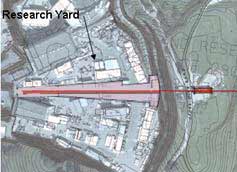

Tuesday - June 6, 2006
SLAC Today is available online at:
http://today.slac.stanford.edu
In this issue:
Designing LCLS for the Future
Safety Today: Mountain Lions
Photo: SLD Assembly Tool Relocated Yesterday
Journey to Antarctica
 |
 |
|
Tuesday - June 6, 2006 |

This diagram of the head house shielding shows the initial LCLS beamline (in red) and the flared design (in pink) that will accommodate additional undulators and beamlines in the future. Designing LCLS for the FutureDesigning and building the Linac Coherent Light Source (LCLS) will be a monumental challenge. Compounding that challenge is how to design it so that it can keep pace with future discoveries—namely, discoveries related to how free electron lasers work in the first place. The original design concept involved building the LCLS as simply as possible. But when the Office of Science gave the final go-ahead to begin the design phase in late 2002, the message was clear: build the LCLS so that future researchers can make use of new discoveries as they go along, without having to build a new laser from scratch. Read more... |
||||||||||||||||||||||||||
|
|
||||||||||||||||||||||||||
SLD Assembly Tool Relocated Yesterday
As the Linac Coherent Light Source (LCLS) project progresses, the topography of the lab is beginning to change. Yesterday afternoon, six contract workers and numerous lab employees relocated the SLAC Large Detector (SLD) Assembly Tool from near the Collider Hall to an open area behind Building 730. Moving the tool, which is used for assembling and disassembling the SLD detector, will allow LCLS construction to proceed. "The LCLS project is taking the path forward and these are exciting times for the lab," said Jesse Saldivar, who headed the relocation project. 
Stanford Safety Alert: Mountain Lions
Recently, these cats have been seen around the Stanford campus. Most of the mountain lions sighted have been young males. Male mountain lions roam large territories, and those nearby are already taken (human encroachment or interruption of habitat to building developments doesn't help); so these young adult males must venture further afield in search of their own territory. San Francisquito Creek, which runs from the hills down behind the Stanford West Apartments and on through Palo Alto to the Baylands is, like other creeks in the area, a wildlife highway which is traversed by mountain lions in their quest for prey and territory. Some venture out of the creek beds onto city streets along the way. People encountering a mountain lion should make themselves look larger—stand tall and wave your arms (don't squat or bend), make loud noise, make eye contact, back away slowly (don't turn your back), and throw a rock or something at him (as long as you don't need to bend over to pick it up). Mountain lions don't want to be seen; give them the opportunity to run away back into seclusion. More information... |
Journey to Antarctica
Pierre Schwob trekked to Antarctica last January for an unusual bounty: meteorites. "They're easier to find here," Schwob said at a talk he gave last Friday in the Kavli Building Auditorium. "Something dark is easy to notice on the white expanse of Antarctica." He joined five other enthusiasts on the expedition: meteorological expert Harry Otten, retired engineer Peter Oberbeck, plastic surgeon William Sullivan, world-class bridge player Chris Dixon, and Sky and Telescope editor-in-chief Rick Fienberg. "We were all type-A personalities, but we survived," said Schwob. The team flew to Punta Arenas, Chile, where bad weather kept them grounded for days. There, Schwob and fellow team members were briefed on conditions and codes of conduct of the continent. "You cannot leave anything behind," Schwob summarized. In fact, "you can't write your initials in the snow because it would last 20,000 years." After five days in Punta Arenas, the skies finally cleared. The team boarded the Ilyushin-76, a Soviet cargo plane "liberated" after the breakup of the Soviet Union, and flew to the Patriot Hill base camp. After a regular landing, where the Ilyushin bumped its wheels over the washboard ice landing strip, the group was stuck again for several more days due to weather. They bided their time practicing looking for meteorites. Schwob also spent hours photographing sastrugi, patterns sculpted into snow and ice by wind, and only seen in Antarctica. After six days, the air was clear to fly to the Pole. Sarah Church, a KIPAC physicist who studies cosmic microwave background radiation, welcomed Schwob. In addition to viewing the scientific equipment used by Church and her associates, Schwob took the requisite pictures at the ceremonial Pole and the geographic Pole, which moves up to twenty feet each year. The pole floats at 9,300 feet above sea level; in some places, the ice is two miles thick. After several days at the pole, the group flew to the Patuxent Range for their meteorite search. Although no meteorites were sighted, Schwob says the journey was a success. His next journey will be a trip to the North Pole, where he plans to touch the ocean floor in a Mirs deep-sea submersible. |
Events (see all | submit)
Access (see all)
Announcements
|
||||||||||||||||||||||||
| | ||||||||||||||||||||||||||
What's Cookin' at the Linear Cafe (see weekly menu)
|
||||||||||||||||||||||||||
|
|
||||||||||||||||||||||||||
 <%
Response.AddHeader "Last-modified", getArticleDate()
'Response.AddHeader "Last-modified","Mon, 01 Sep 1997 01:03:33 GMT"
'Monday, December 06, 2010
%>
<%
Response.AddHeader "Last-modified", getArticleDate()
'Response.AddHeader "Last-modified","Mon, 01 Sep 1997 01:03:33 GMT"
'Monday, December 06, 2010
%>View online at http://today.slac.stanford.edu/ |
||||||||||||||||||||||||||